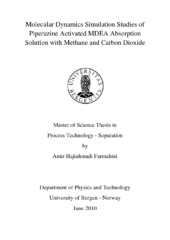Molecular Dynamics Simulation Studies of Piperazine Activated MDEA Absorption Solution with Methane and Carbon Dioxide
Master thesis
Permanent lenke
https://hdl.handle.net/1956/4228Utgivelsesdato
2010-06-15Metadata
Vis full innførselSamlinger
Sammendrag
Regenerative chemical absorption process is widely used in industry for removal of carbon dioxide from natural gas, with activated aqueous solutions of alkanolamines considered a beneficial blend. One of the most promising blends is the aqueous mixture of methyldiethanolamine (MDEA) activated by small amount of piperazine, due to the fairly high rate of reaction of piperazine as a cyclic diamine with carbon dioxide and the low heat of regeneration of MDEA as a tertiary alkanolamine. However, mechanisms involved in absorption of carbon dioxide by means of aqueous piperazine activated MDEA solution are not well understood and available knowledge within the open literature is limited. This thesis aimed to extend our knowledge of the topic by providing insights into the intermolecular interactions involved in mechanisms governing the absorption of CO_2. Furthermore, understanding of the processes associated with the undesired trapping of methane was an additional objective. Characterization of the blend to analyze the distribution of the absorbent and absorbate molecules inside the amine solution was yet another goal for this work. In general, a better understanding of intermolecular interactions and correlations between molecular constituents of the amine solution during the overall process of carbon dioxide absorption from natural gas was expected from this work. To achieve this purpose, MD simulation was chosen as the scientific method to study the system on the molecular scale but prior to starting the simulation, the following had to be accomplished. Initially, an extensive literature review was carried out to determine the speciation of the solution in thermodynamic conditions relevant for absorption units in amine gas treating plants. Moreover, the natural gas was simplified to an impurity free binary mixture of methane and carbon dioxide during the simulation. In order to study the system on the molecular level, we obtained missing force-field parameters by combining the OPLS parameter with ab-initio calculations for piperazine molecule, piperazine carbamate, protonated piperazine and molecular MDEA. To investigate the most important torsional angles in MDEA and piperazine carbamate, geometry of the molecules was optimized and rigid coordinate scan was performed to define true torsional angles, so that ultimately, new functions for dihedral angles of these molecules were derived. In order to calculate the partial atomic charges for all the above mentioned models, Mulliken, Löwdin and CM4 partial atomic charges were computed using 6-31G** basis set and SM8 solvation model. Given the reliability and accuracy of the CM4 charges, they were chosen to be implemented into the final models. Other models for carbon dioxide, methane and water molecules needed for the simulations were taken from literature. Constraint MD simulation was performed at constant temperature using MDynaMix Ver.5.1 for one primary and four reference systems. It was observed that the MDEA was separated from aqueous phase and positioned alongside the gas- liquid interface. Moreover, it was determined that piperazine molecules were spread within MDEA phase, while protonated piperazine and piperazine carbamate mainly dissolved in the water bulk. Hydrogen bond network inside the solution was...
Utgiver
The University of BergenOpphavsrett
The authorCopyright the author. All rights reserved
